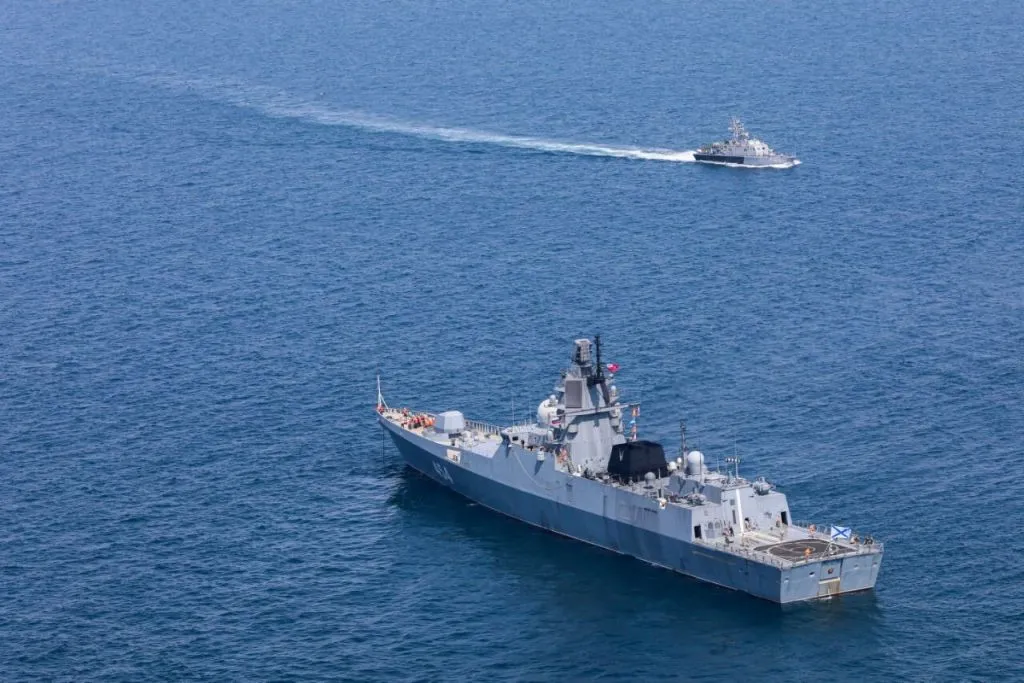AhlulBayt News Agency: Following the commencement of the Zionist regime's conflict with Gaza in the last five months, China has conducted its second joint exercise in the Indian Ocean. In November, just one month subsequent to the Gaza conflict, Chinese forces engaged in joint maneuvers with Pakistan in the Arabian Sea, deploying guided missile destroyer PLA. The Chinese nationalist publication Global Times described this exercise at the time as the 'most extensive' ever conducted between the two nations.
Recently, the Chinese Ministry of Defense announced that, in tandem with the escalation of armed conflicts in the Red Sea, Beijing has commenced a five-day joint military exercise with Russia and Iran in the waters of the Arabian Sea and the Indian Ocean. As per the ministry's statement released on Monday, the navies of China, Iran, and Russia will undertake the joint exercise titled "Maritime Security Belt - 2024" from March 11th to 15th (Monday to Friday) in the waters adjacent to the Gulf of Oman in the Indian Ocean. The statement indicates that China has deployed its 45th Escort Task Force, which includes the guided missile destroyer Urumqi, guided missile frigate Linyi, and the large supply ship Dongpinghu, with the objective of safeguarding the collective maritime security of the region.
Chinese military maneuvers simultaneous with the Gaza war
Following the onset of the conflict between the Zionist regime and Gaza in the past five months, China has now conducted joint military exercises in the Indian Ocean for the second time. In November, just one month after the Gaza conflict, China participated in joint drills with Pakistan in the Arabian Sea, which included the guided missile destroyer PLA. The Chinese nationalist newspaper, Global Times, described this exercise as the "largest ever" held between the two nations.
Presently, it seems that China is aiming to showcase a form of strategic alignment with its Iranian and Russian counterparts in the region. China, having stationed its warships at the Djibouti naval base near the Red Sea, has refrained from officially condemning the Yemeni forces attacks and, according to Reuters, has instead called for de-escalation of tensions in the Red Sea. This nuanced stance may also serve as a signal to the United States to exercise restraint in further involvement in the Red Sea.
The trilateral military axis Beijing-Tehran-Moscow
Besides China's notable involvement in the drills conducted in the Oman Sea and the Indian Ocean, the Russian Ministry of Defense has declared that its Pacific Fleet, under the leadership of the guided missile cruiser Varyag and the destroyer Marshal Shaposhnikov, has docked at the port of Chabahar in Iran to partake in the collaborative exercise. Russian vessels will also engage in the joint Maritime Security Belt - 2024 exercise.
Moreover, Iranian naval assets, including vessels, boats, and maritime aircraft, are set to join this exercise. Alongside the Chinese and Russian fleets, over 10 Iranian naval vessels and three helicopters will also be participating. Rear Admiral Shahram Irani, commander of the Islamic Republic of Iran Navy, announced last month that Tehran plans to conduct a joint exercise with Beijing and Moscow by the end of March to uphold regional security.
Furthermore, the Russian Ministry of Defense has indicated that representatives from the navies of Pakistan, Kazakhstan, Azerbaijan, Oman, India, and South Africa will serve as observers in this exercise.
The ongoing trilateral naval exercise involving Iran, Russia, and China follows a similar five-day naval drill conducted in the Arabian Sea one year ago under the banner of Maritime Security Belt - 2023. Last year's exercise featured China's Nanning destroyer, Iran's Jamaran light frigate, and Russia's Admiral Gorshkov-class frigate. Now, once again, these three nations are showcasing a consistent and unified military collaboration by conducting a joint exercise in the waters of the Oman Sea.
The continuity between last year's exercise and the current one suggests that the three countries have established long-term plans for military and security cooperation, with expectations for this trend to persist in the future. Consequently, if the ongoing trend of military cooperation among Tehran, Beijing, and Moscow continues, the establishment of a trilateral military bloc and agreement among these parties may proceed more smoothly in the years ahead.
Prominent collaborations
Conversely, Beijing has upheld
strong ties with Moscow throughout the entirety of the conflict in
Ukraine and has bolstered economic collaboration. Despite Western
attempts to isolate Russia, China's relationship with Moscow remains
unaffected. Nonetheless, China has avoided openly endorsing Russia's
actions in the Ukraine conflict. Reports from outlets like the Telegraph
suggest that China may be clandestinely providing arms to Russia.
Meanwhile, Iran and Russia have expanded their military and political
partnership in recent years. These joint efforts have naturally
intensified in light of shared security concerns, with US and Western
sanctions against Iran failing to impede oil trade between Iran and
China, as Iran continues to serve as a key energy supplier for China.
The deepening of trilateral cooperation can be attributed to the
existence of mutual interests among the three parties, and it's unlikely
that these shared interests will undergo significant changes in the
foreseeable future. As a result, trilateral cooperation within the
Russia-Iran-China alliance is expected to grow even stronger in the
years ahead.
/129

